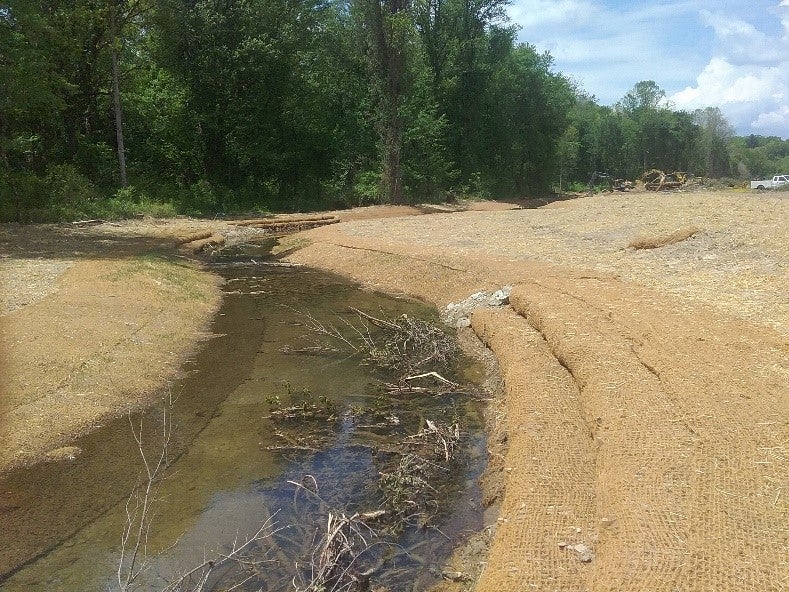Like many cities across the country, Hendersonville, North Carolina, is grappling with how to protect its residents and infrastructure from extreme weather events, which have increased fourfold nationally since 1980.
The western part of the state, where Hendersonville is located, recorded its wettest period on record between 2015-2018 [PDF]. This influx of water accelerated streambank erosion and threatened the city’s critical sewer and drainage infrastructure, which was not built to withstand the new normal of extreme rainfall.
City officials turned to nature to address the problem. In so doing, they better protected their infrastructure and provided a model for other municipalities seeking solutions to address similar challenges.
These three strategies contributed to Hendersonville’s success.
1. Natural solutions can save costs and build long-term resilience
Public works departments often rely on riprap, sandbags or other structural solutions to shore up eroding streambanks. While these measures are relatively inexpensive, costs add up over time as these approaches fail to address the root cause of erosion, which occurs when streams are unable to access their floodplains during heavy rain events.
Hendersonville instead found a solution that would address the underlying cause of erosion while also providing environmental and aesthetic benefits.
The Multi-Area Streambank Restoration Project will restore nearly 2.5 miles of stream to protect buried sewer infrastructure from streambank erosion and to reduce the likelihood of sanitary flow reaching waterways.

Stream restoration involves a mix of engineering, heavy equipment operation and ecological design to return an impaired or eroding stream to its natural form. This work includes recontouring eroding streambanks to create floodplains that slow and retain excess water during storms, using logs or boulders to create pools and capture silt and sand, and planting native vegetation to shade the stream and protect the soil.
The city selected ecological methods instead of structural measures because stream restoration is the longest lasting and most aesthetically pleasing way to protect infrastructure. Once complete, officials expect the project to provide lasting protection for sewer infrastructure while also improving water quality, providing wildlife habitat and reducing flood risk during storm events.
2. Creative financing helps get projects off the ground
Hendersonville officials sought creative funding opportunities for the restoration project.
The North Carolina Division of Water Infrastructure provides 0% interest loans to municipalities that implement certain approved practices for water quality, including stream restoration. These loans come out of the state’s Clean Water State Revolving Fund [PDF], which receives grant money from the U.S. Environmental Protection Agency and grows as loans with interest are repaid.
Hendersonville secured approximately $3 million from the state’s revolving fund at a 0% interest rate and will repay the loan using revenue from the city’s water and sewer enterprise fund. The combination of a zero-interest loan and a dedicated water and sewer fund enabled the city to holistically address its infrastructure risk. This city in North Carolina used natural solutions to build long-term resilience to flooding, while also protecting critical infrastructure. Here's how. Share on X
3. Staff development and public engagement create lasting buy-in
Hendersonville’s approach provides lessons for other municipalities interested in addressing infrastructure risk from stream erosion. First, education matters. Staff from Hendersonville participated in the Stream Restoration Program at North Carolina State University to better understand the advantages of ecological restoration.
Second, engage the public. Hendersonville’s restoration project consists of over a dozen restoration sites, many of which were initially discovered and monitored by property owners. In addition to empowering the public to identify areas of concern, city staff involved property owners in project design by hosting open houses to show them project plans and allow them to ask questions and provide feedback. This trusted partnership between the city and its residents led to the success of the overall effort.
As municipalities across the nation grapple with how to manage waterways and protect infrastructure as a changing climate brings heavier, more variable rainfall, Hendersonville’s streambank restoration project provides an important model for how to bring together nature, funding and people to build long-term resilience.

A sloped streambank gives way to a broad, flat floodplain, reducing erosion risk for existing sewer infrastructure. Photo courtesy of the City of Hendersonville and Baker Grading and Landscaping.
A longer version of this blog post appears in Stormwater Magazine. You can read the case study in full on their website here.










2 Comments
Part of the problem is that the county is getting very overbuilt that the water is being diverted to other areas. People don’t seem to consider flooding before they build then want to be bailed out when it does flood.
Poor planning!
Excellent articles! Thank you